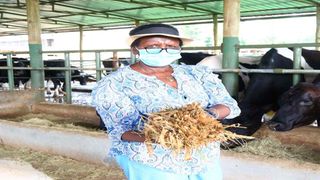
Anne Mwangi tends to her animals at Meved Dairy Farm in Rukanga in Kirinyaga County on December 28, 2021.
| Joseph Kanyi | Nation Media GroupSeeds of Gold
Premium
My one-stop shop dairy enterprise
What you need to know:
- Anne Mwangi milks 57 animals and sells yoghurt and other products at her farm shop.
- Her thriving business has revolunised dairy farming in an area that is semi-arid.
A white signpost erected on a shipping container welcomes Seeds of Gold team to Meved Dairy Farm, some 60 kilometres from Nyeri town.
At the farm shop, located near the entrance, some motorists have stopped by to purchase yoghurt.
Not far from the gate is a wooden loft that houses over 2,900 chicken as well as a hay barn.
Anne Mwangi, the director of the farm, meets us after we have disinfected our feet at the footbath. She had finished conducting the day’s inspection of the farm to ensure everything goes right.
As she starts the tour of the farm, our eyes pick out a dairy meal processing unit at the middle of the first block of the cowsheds while a board displayed prominently on a wall shows details of each of the cows and heifers in that block.
“Every block has a chart that guides us on the herd composition, capturing details such as the number of heifers, those lactating, calvers, weaners and those in-calf,” she says.
Inside the cowsheds, the animals are clustered according to age, condition (in-calf), heifers, bulls and so on.
"We stop giving the calves milk at three months and we slaughter the bulls at 14 months and sell the meat. The heifers are reared for milk production," she says, adding that they are inseminated after attaining 350kg.

Anne Mwangi at her Meved Dairy Farm in Rukanga in Kirinyaga County on December 28, 2021.
Before starting the farm, Anne recounted that she would travel to Nyeri town in search of milk for use whenever she visited her rural home, which is located in Rukanga, Kirinyaga County.
“This area is generally dry thus most farmers cultivate fast-maturing crops with the little rain that comes. They didn’t keep cows then though some have now taken up to the trade.”
She started the farm in 2007 after moving back to her rural home.
“We began with one cow which we cross-bred with a hybrid to increase our milk production,” she says, adding that by 2008 she had seven animals that were producing 150 litres of milk.
The farm has been growing since then and currently hosts Friesian animals, 42 which are heifers, 90 mature (57 of them that are lactating) and 18 bulls. The lactating animals produce 1, 200 litres in a day.
At first, she chose to sell her milk to Kenya Creameries Company (KCC) in Nyeri twice a week at between Sh23 and Sh40, depending on the season.
“The prices were not good for my business because the cost of production a litre of milk is Sh32 while they were paying Sh23 during the peak season. I withdrew from KCC and started to make yoghurt.”

Anne Mwangi tends to her animals at Meved Dairy Farm in Rukanga in Kirinyaga County on December 28, 2021.
She produces various yoghurt varieties that she sells at Sh180 per litre and maziwa lala with and without sugar that retail at Sh100 per litre.
She started processing her own feeds after suffering losses due to substandard feeds.
“The feeds were expensive but not beneficial to the animals. The dairy meal quality was compromised. We buy our feed ingredients from Tanzania, they are expensive but our production compensates for that,” says Anne, who employs 12 workers.
The cows are milked thrice a day using machines and they are fed on hay, maize silage, sweet potato vines, legumes and dairy meal.
To keep the farm running, Anne says that proper housing and planning for rainy days by growing and preserving fodder is key in ensuring that cows maintain their productivity.
"We make sure that we have fodder that lasts the animals for months to beat the erratic weather patterns,” says the former Ministry of Health employee.

A worker tends to dairy cows at Meved Dairy Farm in Rukanga, Kirinyaga County on December 28, 2021.
A good cowshed, according to her, must ensure that the animals move with ease and should protect them from external weather conditions such as rain, wind and direct sunlight.
Each of her animals has a cow mattress that guarantees it comfort when it rests while the walking area in the cowsheds has rice husks to keep it dry and protect the cow feet.
One of her challenges is water scarcity, which she has tried to alleviate by drilling two boreholes.
"The weather pattern is terrible, we are also using the water to grow maize for silage, what brings the challenge.”
Charles Njoroge, a livestock officer in Nyeri County, says availability of quality feeds is key in dairy production. “One should not over-rely on napier grass and commercial feeds which sometimes are compromised.
“For a farmer to break even, each cow should produce 15 litres per day. Raising cows that produce more while consuming little helps. In dairy, only volumes matter because when you are producing little and the prices are good, you cannot enjoy. Farmers should always maximise their production,” he says.





